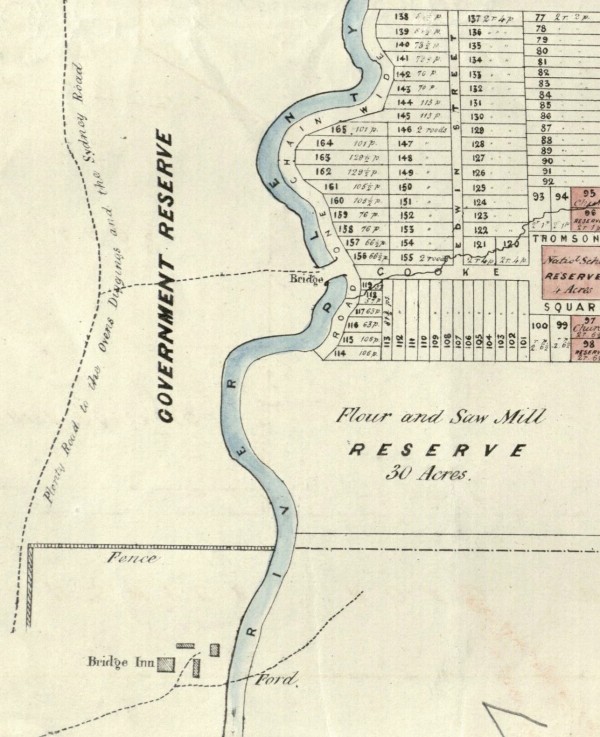In 2015, the Level Crossing Removal Authority (LXRA) commissioned Dr Vincent Clark & Associates to carry out cultural heritage investigations for the Mernda Rail Extension Project. Although the site of the Old Bridge Inn (Victorian Heritage Inventory site H7922-0374) was outside of the area being affected by the railway extension, Heritage Victoria and LXRA agreed to support Victoria’s first off-set project where significant, local, historical sites could be investigated even though they would not be impacted by the proposed development project. The Old Bridge Inn archaeological project proceeded with the support of LXRA, Heritage Victoria, Parks Victoria, the City of Whittlesea and the consent and participation of the Wurundjeri Tribe. This project has been managed as a research-focused, community engagement project and has provided an unparalleled opportunity to investigate the Aboriginal and early colonial occupation of Mernda.

The Old Bridge Inn is one of the earliest commercial structures outside of Melbourne with a hotel license granted in 1841, and this business is still in operation today as The Bridge Inn Hotel.
It was constructed by the Willis brothers on a local track and river crossing point at a ford on the Plenty River. In 1851, the farm and inn were purchased by Moses Thomas, a local entrepreneur and one of the key figures in the development of Mernda. Thomas and his family moved into the inn and ran the farm as well as the hotel and a flour mill from this location.
After the establishment of Plenty Road and the increased traffic along it to the central Victorian goldfields, the patronage of the inn was in decline, so Moses Thomas moved the business to a new location on the Plenty Road in the 1860s. The Old Bridge Inn site beside the river was abandoned, and was eventually demolished.
The archaeological investigations at the site comprised several stages. The first stage was a geophysical surface survey of the ground to see if any buried features or structures were present. This survey was made possible by the City of Whittlesea and was conducted by GBG Australia with the assistance of Dr Vincent Clark and Associates. The results of this survey indicated that several structural features were present at the site.
Parks Victoria conducted and aerial drone survey of the site to capture imagery of the landscape prior to archaeological excavations proceeding.
The second stage was a landscape archaeology analysis of the site and surrounding area. A surface survey of the site and the surrounding river banks to gain a better understanding of other historical features that may be related to the Old Bridge Inn site, including the original ford, bluestone walls and other local historical sites such as Mayfield Farm, Berry Lane and the Thomas Mill site.
The third stage was the archaeological excavations which revealed a much larger main building than was expected, considering that the inn was originally listed as a wattle and daub hut. Much of the bluestone cobbling surrounding the building was intact, as well as the remains of three hearths. Intact archaeological deposits were found containing artefacts that shed light on the kinds of activities that took place, the food that was eaten, and the people who used the site. These will provide a detailed picture of the life of the inn in the mid-late 19th century.
3D photogrammetry and 3D laser scanning of the site was conducted with the assistance of RMIT student, James Livesey, and these techniques have been used to document the site in detail and to produce a highly realistic 3D model of the site.

Importantly, three distinct phases of occupation were identified. The first and earliest was a prehistoric phase with indigenous Australians occupying the site, as evidenced by the many stone tools found in layers below the inn’s structure. The second phase was the construction and occupation of inn from the late 1830s until the 1860s, and this included the inn building remains, and many historical artefacts. The third phase was unexpected, and represents a final occupation of the abandoned building by indigenous people, who re-occupied the building and who were living a traditional lifestyle using stone tools, but also ingeniously making tools out of new materials like glass.
Local school groups visited the site over several days and learned about the archaeology of the inn and its history, but also had a talk and demonstration by Wurundjeri elder, Perry Wandin, about how local indigenous people lived in the Plenty Valley prior to European colonisation. Descendants of the Willis and Thomas families and local and state government representatives were also hosted at the site for a special tour during the project.
After the excavation was completed, an open day was hosted by archaeologists from Dr Vincent Clark & Associates, Heritage Victoria and LXRA staff and Wurundjeri elders provide the local community with an opportunity to visit the excavations while they were still open, view artefacts and talk to archaeologists, local historians and other specialists. This day was a great success and saw hundreds of people attending, despite the wintery conditions.
Acknowledgements:
Dr Vincent Clark and Associates would like to thank Jeremy Smith and Brandi Bugh from Heritage Victoria; Ian Clark, Crystal Serblan and Claire Fiddian of LXRA; Ross Mugavin, Vanessa Bluett, Faye Williams, and Bill Pitt from Plenty Gorge Park, Parks Victoria; Perry Wandin, Brendan Wandin and Shane Nicholson from the Wurundjeri Tribe Land and Compensation Cultural Heritage Council; Colleen Lazenby from City of Whittlesea; Natalie Jiricek from the AECOM/GHD Joint Venture; Simon Cook from GBG Australia; James Livesey from RMIT; all the student archaeologists from La Trobe University, Monash University and the University of Melbourne.
Press Releases
